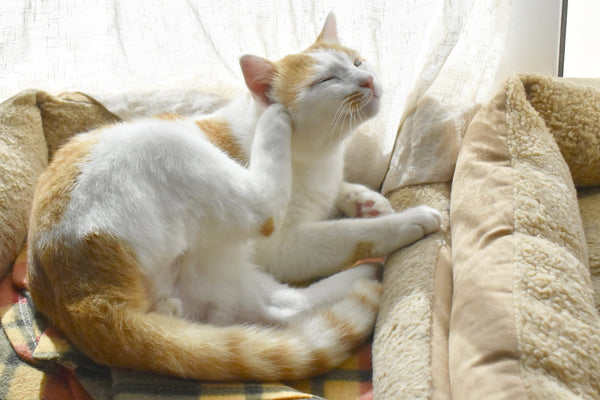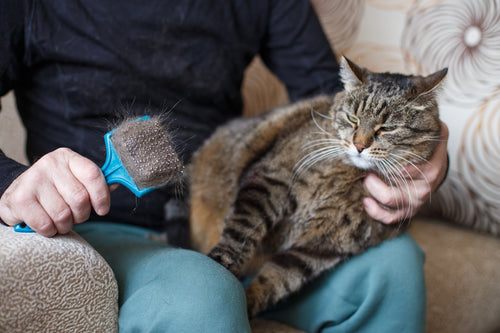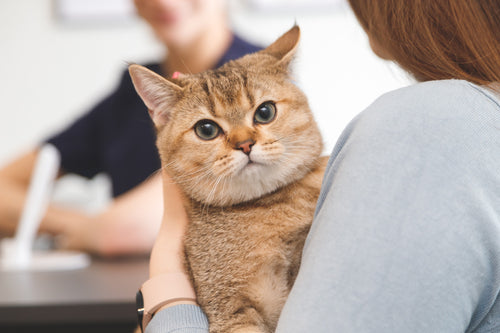Cats are known for their keen senses, particularly their hearing. However, like humans, cats can also experience ear problems that can affect their overall health and well-being.
Two common ear problems in cats are ear mites and fungal infections, more specifically yeast ear infections. While both conditions can cause discomfort and irritation for our feline friends, it's important to understand the differences between them to properly treat your cat's ears.
In this article, we'll discuss the causes, symptoms, and treatment options for ear mites and yeast infections in cats, helping you to better understand these common ear problems and how best to care for your cat's ears.
Understanding Cat Ear Mites
Ear mites are one of the most common parasites found in cats. These microscopic organisms, live in the ear canal and feed on the ears wax and oils. They can cause immense irritation, leading to secondary bacterial infections if left untreated.
Causes
Ear mites can be acquired from direct contact with an infected animal or their environment. They thrive in warm, moist conditions, making them more prevalent during the summer months. Cats living in crowded or unsanitary environments are also at a higher risk of contracting ear mites.
The top environments to watch out for an ear mite infestation are:
- Boarding facilities
- Shelters
- Kennels
- Animal shelters
- Multi-cat households
Symptoms
- Excessive scratching of ears and head, causing skin lesions
- Head shaking
- Redness and inflammation in the ear canal
- Dark, crumbly discharge resembling coffee grounds
- Strong odor from the ear
Diagnosis
Ear mites are usually diagnosed through a physical examination and microscopic evaluation of the ear discharge, often called an otoscopic exam. Your veterinarian may also take skin scrapings to confirm the presence of ear mites.
Treatment
The good news is that treating ear mites is usually straightforward! To treat ear mites, your veterinarian will likely prescribe a topical or systemic parasiticide to kill the mites. Remember, since mites can easily spread, it's essential to treat all pets in a household.

Exploring Yeast Infections
Yeast infections, occur when the naturally occurring fungus Malassezia pachydermatis overgrows in the ear due to an underlying condition (such as allergies or a weakened immune system).
Causes
A fungal infection, such as a yeast infection, can be caused by several factors, including:
Allergies (Food or Environmental)
Allergies can cause inflammation and irritation in the ears, creating a favorable environment for yeast overgrowth.
Hormonal Imbalances
Changes in hormone levels, such as those that occur during pregnancy or with certain medications, can disrupt the balance of bacteria and fungi in the ear.
Endocrine Disorders
Conditions like diabetes and Cushing's disease can weaken the immune system, making cats more susceptible to generalized fungal infections.
Moisture in the Ears
Yeast bacteria and fungal spores love moist environments, making cats who love to swim or regularly bathe at a higher risk for ear infections.
Use of Certain Medications
Medications such as antibiotics or corticosteroids can disrupt the balance of bacteria and fungi in the ears, making cats more susceptible to yeast infections.
Symptoms
A yeast infection in the ears can show up as a few distinct symptoms such as:
- Excessive shaking of the head
- Scratching or pawing at the ear
- Redness and inflammation in the ear canal
- Thick, brown discharge resembling cottage cheese
- Strong odor from the ear
Diagnosis
Yeast infections are diagnosed through a physical examination, otoscopic exam, and evaluation of ear discharge under a microscope. Your veterinarian may also take skin scrapings to confirm the presence of yeast.
Treatment
Treatment for yeast infections usually involves cleaning the ears and applying an antifungal medication directly into the ear canal. In some cases, your veterinarian may treat yeast infections with oral medications or recommend dietary changes to address underlying conditions.
Similarities and Differences Between Ear Mites and Yeast Infections
Cause Comparison
Both ear mites and yeast infections can be caused by environmental factors, such as allergies or moisture in the ears. However, ear mites are parasites that can be acquired through direct contact with an infected animal or environment.

Symptoms Comparison
Both ear mites and yeast infections can cause similar symptoms, such as excessive scratching, head shaking, and a strong odor from the ears. However, a key distinction is that ear mites often produce a dark discharge resembling coffee grounds, while yeast infections tend to have thicker, brown discharge.
Do note that your cat's symptoms may look different compared to other cats. If you're in doubt, be sure to contact your vet for a proper diagnosis.
Diagnosis Comparison
Both ear mites and yeast infections can be diagnosed through a physical examination and otoscopic exam. However, diagnosis of ear mites may also require microscopic evaluation of ear discharge, while yeast infections may require additional skin scrapings.
Treatment Comparison
While both conditions require addressing their underlying causes for effective treatment, the methods may differ. Ear mites are typically treated with parasiticides, while yeast infections require antifungal medications.
Prevention Tips
Maintaining your cat's ear health is essential for preventing both ear mites and yeast infections.
Here are some proactive measures you can take:
Maintaining Ear Hygiene
Helping your cat maintain ear hygiene by regularly cleaning your cat’s ears with a pet-formulated solution can help remove excess wax and discourage the growth of pathogens. Be sure to use a gentle touch and involve positive reinforcement to make the process less stressful for your cat.
Regular Vet Check-Ups
Yearly veterinary check-ups can help catch any potential issues before a secondary infection occurs. Vets can perform thorough ear examinations and advise on proper cleaning techniques specific to your cat's needs.
Controlling Moisture
Keeping moisture out of your cat's ears can help prevent the overgrowth of yeast. Dry your cat's ears thoroughly after swimming or bathing, and avoid using cotton swabs, which can push debris further into the ear canal.
Avoiding Exposure to Infected Animals
If you suspect that your cat has been exposed to an infected animal, keep them apart until the other animal has been treated. This will minimize the risk of infection spreading.
Checking Routinely for Ear Mites
If you have multiple pets, it's a good idea to routinely check their ears for any signs of ear mites. This can help catch and treat the issue early on, preventing further spread to other animals.
FAQs
Q: Can ear mites and yeast infections be passed to humans?
A: No, ear mites cannot survive on human skin, and yeast infections are not zoonotic (i.e. cannot be transmitted between animals and humans).
Q: Are all cats susceptible to ear mites and yeast infections?
A: Yes, any cat can develop an ear mite or yeast infection, but certain factors such as age, health, and lifestyle may increase their susceptibility.

Q: Can I prevent ear mites and yeast infections by keeping my cat indoors?
A: While keeping your cat indoors can reduce their exposure to other infected animals, it does not guarantee prevention. Proper hygiene and regular vet check-ups are still necessary to prevent these conditions.
Q: Is it safe to use over-the-counter treatments for ear mites and yeast infections?
A: No, we don’t recommend using any medication without consulting a veterinarian first. Improper treatment can worsen the condition or cause other health issues. Remember, every cat's situation is unique, so always seek professional advice.
Q: Can I use the same ear-cleaning solution for both ear mites and yeast infections?
A: No, it is important to use a specific solution recommended by your veterinarian for each condition. Using the wrong solution can be ineffective or even harmful.
Q: Can my cat develop immunity to ear mites and yeast infections?
A: While cats can build immunity to certain infections, they are still susceptible to recurring ear mites and yeast infections. Proper prevention measures should be taken to minimize the risk of recurrence or secondary infections.
Q: Can ear mites or a fungal infection cause permanent damage to my cat's ears?
A: If left untreated, both conditions can lead to serious complications such as hearing loss or chronic ear infections. Seeking prompt veterinary care is crucial for avoiding long-term damage.
Q: Are there any natural remedies for preventing ear mites and yeast infections?
A: While some home remedies may provide temporary relief, they are not a substitute for proper veterinary care. Natural oils or solutions can irritate the ears or mask symptoms, making it difficult to diagnose and treat the underlying condition.
Q: Is it normal for my cat to have some ear wax?
A: Yes, it is normal for cats to have a small amount of ear wax. However, an excessive buildup or changes in the color or consistency of the wax may indicate an underlying issue and should be checked by a veterinarian. In general, maintaining proper hygiene can help prevent excessive wax buildup.
Conclusion
Ear problems in cats are not to be taken lightly, but with the right knowledge and prompt action, they can be effectively managed. Whether it's the resilient yet pesky ear mites or the opportunistic yeast infections, understanding the various signs and treatments is crucial.
Remember, your vigilant eye and quick response can make all the difference in your cat's ear health, ensuring they live a life free of unnecessary discomfort. If you suspect your cat may be experiencing ear trouble, don't hesitate to seek professional veterinary care. Early detection and appropriate treatment are paramount in ensuring your cat’s ears stay as healthy as can be!
Interested in learning more about keeping your cat in optimal health? Be sure to check out our blog for more informative articles!





